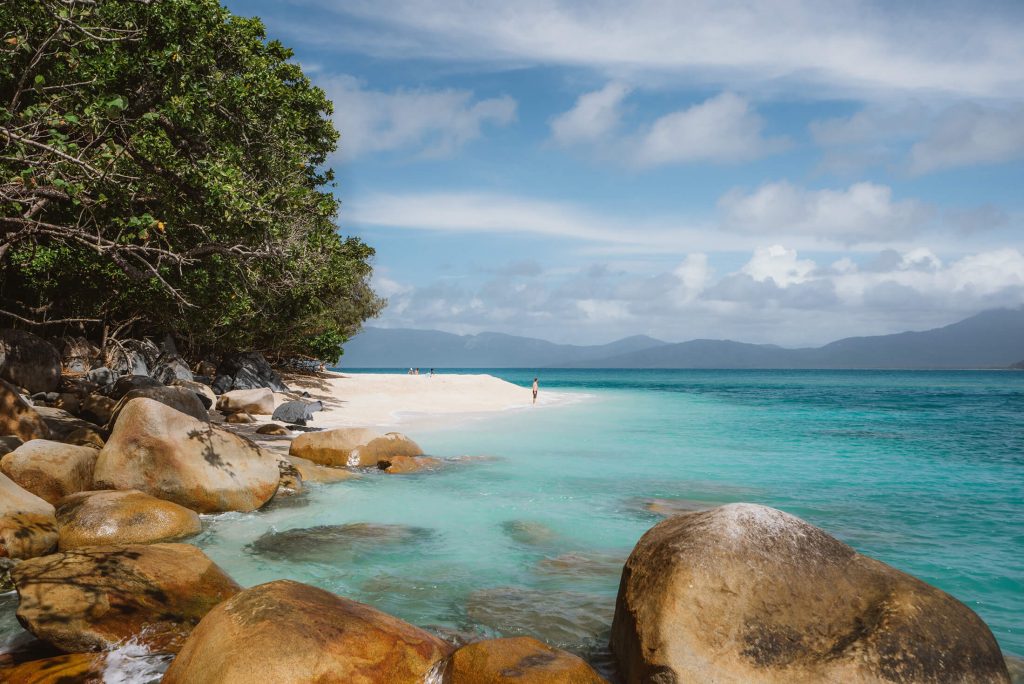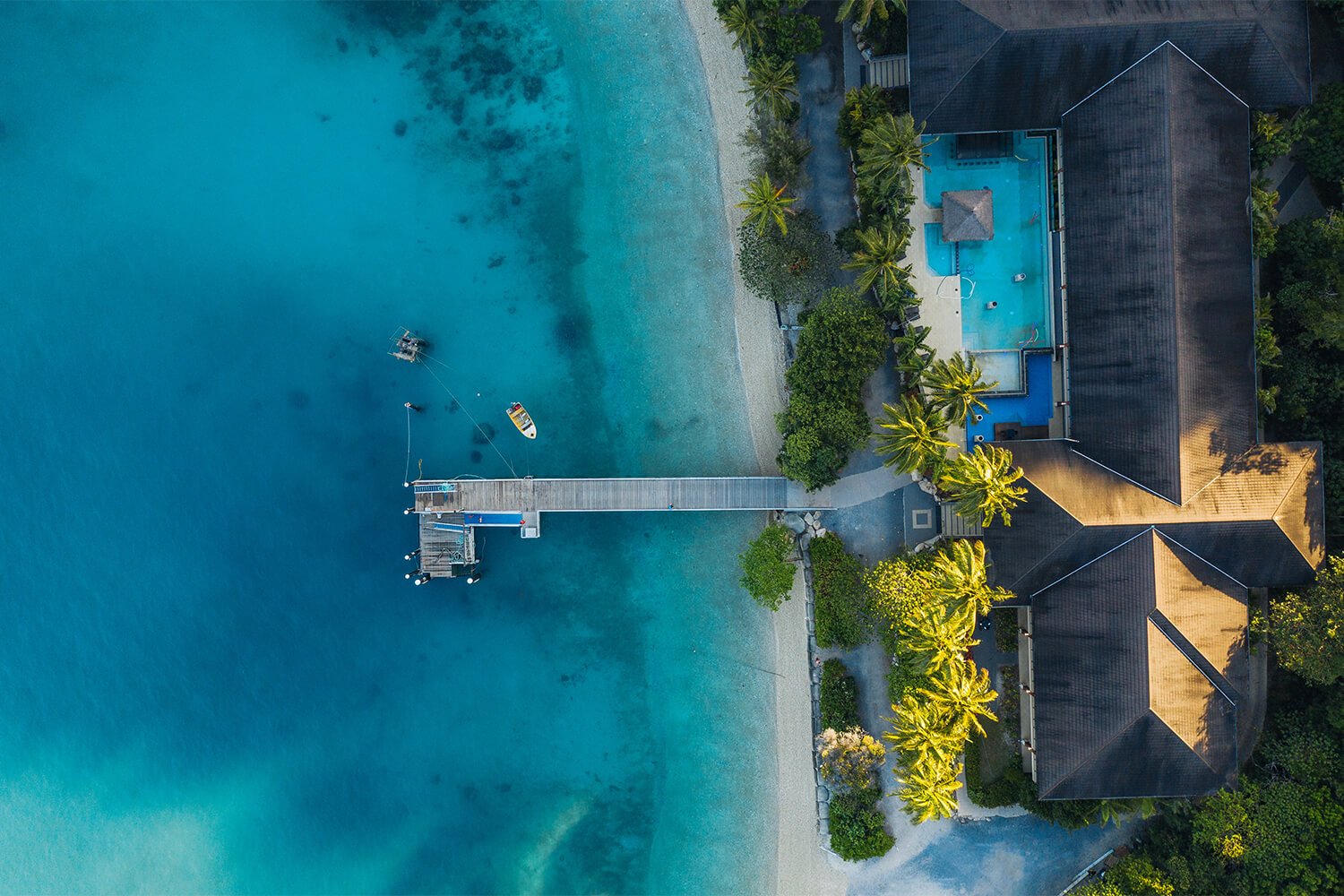TNQ Writer
Travel writer Lee Mylne has visited Queensland’s precious Great Barrier Reef multiple times. On a visit to Fitzroy Island she reflects on the joy her young grandson Ollie would take in this natural wonder.
This article was produced in partnership with News Corp Australia.
In the clear turquoise water off Hidden Beach on north Queensland’s Fitzroy Island, a young green sea turtle swims lazily past and my eyes widen behind my snorkel mask. It’s a gift, seeing those shining flippers make their easy strokes in the water below me.
I’ve visited Cairns and the Great Barrier Reef region perhaps a dozen times over the past 30 years or so, but Fitzroy Island and the tropical waters and fringing reef around it have always held a special appeal. Now, with travel out of the question at least in the near future, my mind often turns to the places l’ve been and the stories they hold.

Fitzroy Island Main Beach & Resort
From Cairns, the ferry takes about 45 minutes to cover the 29km to Fitzroy, giving time to shake off the shackles of mainland life and slow to a more languorous pace. Last time I was here, it was aboard a private yacht, the first stop on a lazy sailing holiday cruising the Queensland coast.
That idyll was a far cry from most of my visits to Cairns and the Great Barrier Reef – including this one – as a travel journalist. I was with friends; not alone or with colleagues on a similar assignment, as I am on this visit.

Nudey Beach has been voted one of Australia's best beaches
In the cool early morning, I take the bush track from Fitzroy Island Resort across the hill to Nudey Beach. As I reach the deserted beach, coral crunches under my shoes. The only other creatures here are a lone blue heron and a pair of Orange-footed scrubfowl. I find a perch on one of the large granite boulders that line the beach, smoothed by the lapping sea, and watch a juvenile Blacktip reef shark hunting small fish in the shallows.
The sea birds are unfazed by my presence, and I feel a familiar pang of regret that I’m alone in this lovely spot. It’s part of the job description of a travel journalist, and not for the first time on assignment I find myself wishing I had someone special with me to share the moment with.
In this case, my mind goes straight to the latest love of my life, my grandson Oliver. Not yet two years old, he’s already fascinated by birds, his chubby finger often pointing to the sky or a nearby tree as he gazes upward. “Bir…bir…”, the almost formed word was his first.

Spot turtles surfacing for air
And in these times when I can only see him online, I think about the many other reasons to dream about one day – when he is older – bringing Ollie to Fitzroy Island. What child can resist the sight of a turtle’s head bobbing up in the water, the sunshine glinting on its gleaming shell, let alone the chance to swim with them?
Turtle sightings in the waters around Fitzroy are almost guaranteed; the Great Barrier Reef is home to six of the world’s seven species of marine turtles. As we arrived, even the grown-ups were thrilled by the welcome from a young green sea turtle who has become the resort mascot – dubbed Michelle – for her regular appearances below the jetty when the ferry docks. Like all visitors to the Great Barrier Reef Marine Park, we have contributed a $7 Environmental Management Charge which goes towards reef conservation.

Fitzroy Island Resort is located right on the beach
A former backpackers retreat, Fitzroy Island Resort has recently undergone a $2.5 million upgrade to make it a comfortable family-friendly resort, where accommodation ranges from studios to a four-bedroom penthouse, and a beachfront row of six bungalows, shaded by coconut palms, that sleep five.
Guests can also take sailing trips aboard the 16-metre catamaran Eye Spy, to snorkel the reef, often accompanied by resident marine biologist Azri Saparwan, one of the Great Barrier Reef’s 46 Master Reef Guides, who also runs a range of ‘citizen scientist’ tours for visitors. Our outing to Hidden Beach reveals colourful corals and schools of small fish, and – for some among us – the sleek shape of a small reef shark.

Explore the island on a stand-up paddle board or kayak
Ollie’s got energy to burn and I’m pretty sure he’ll also be keen to splash about in the resort’s children’s pool – much bigger than his bathtub – or the larger pool, with its swim-up bar and spa pool. If, like me, he keeps coming back throughout his life, he’ll be a starter for the stand-up paddle boards and glass-bottom kayaks.
Kids are also delighted by the daily fish-feeding off the jetty, but the place I really want to bring Ollie is along a bush track a few minutes’ walk from the resort.

Visit the Cairns Turtle Rehabilitation Centre
The tanks are an off-shoot of the Cairns Turtle Rehabilitation Centre, sponsored by Fitzroy Island Resort, and a tour of the centre is enough to satisfy the most ardent turtle fan, while teaching Ollie’s generation some important lessons. It’s also good to know that the $11.50 entry fee to the centre goes directly back to helping the turtles.
On a tour with centre co-founder Jennie Gilbert, who works with a team of 60 volunteers to care for the turtles, I wish once again that I was sharing this experience.
Each turtle’s story is both sad and a warning, their plight often caused by human activity.
Shaz had a plastic six-pack ring tight around her neck and a badly sunburned shell, while Portia arrived with spear holes in the back of her shell. Both green sea turtles were suffering from “floater syndrome”, where air is trapped between the shell and body, making them vulnerable to being hit by boats and hindering their ability to dive and feed, often leading to starvation.
“My favourite is Lou,” says Jennie. “He’s old and ornery, an olive ridley turtle who is a definite cranky pants.
Lou has only two flippers – one on each side – after being tangled in a ‘ghost net’.

Learn about human threats to turtles on a guided tour
A visit here, when he is older, would teach my grandson that threats to turtles are numerous: plastic bags, particles and pellets, along with discarded fishing nets, Styrofoam beads, balloons, and monofilament fishing line. All these have been discovered in the stomachs of dead turtles who mistake plastic bags and plastic sheets for jellyfish or other food.
Jennie says the odds of a turtle surviving 30 years, to breeding age, are worsened as global warming creates warmer nesting sites, the temperature determining that fewer male turtles will hatch, and rising sea levels wipe out many existing sites. To say nothing of the hazards of marine debris and pollution.
“Only one in 1000 turtles survives to adulthood,” she says. “But for every one that returns to the ocean and breeds, we have more turtles. It’s simple: every turtle makes a difference.”
Over the past 20 years, the Cairns Turtle Rehabilitation Centre has treated and released more than 170 turtles, all fitted with satellite trackers. Perhaps next time I come, Ollie and I will be able to help out at the centre, or time our visit to witness a turtle’s joyful release back to the ocean.
Meanwhile, it’s enough to know that every visitor, just by taking a tour, by listening and learning, is already making a difference.










